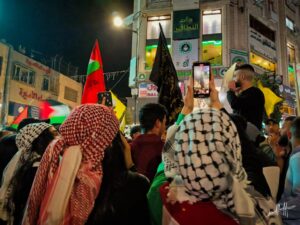As war rages on in Gaza and along the Lebanese border, the West Bank has taken a backseat in the news in the wake of Israel’s unrelenting genocide. Absent the proliferation of small pockets of armed resistance in refugee camps and urban centers in the north, the West Bank has maintained an uneasy sense of calm.
This silence is uncharacteristic. In previous years, Palestinians in the West Bank have reacted to the occupation’s crimes through a series of mass mobilizations, daily clashes with Israeli troops, general strikes, and campaigns of civil disobedience. The First Intifada of 1987, although beginning in Gaza, was mobilized into a united and organized movement in the West Bank, a role which it has continued to play in the thirty-odd years since.
This includes the “Unity Intifada” in May 2021, when Palestinians in the West Bank, Jerusalem, and ‘48 Palestine rose up in a collective reaction to Israeli attempts to expel Palestinian families from their homes in Jerusalem’s Sheikh Jarrah neighborhood. The wave of mass protests across the West Bank’s cities was larger than it had ever been, reaching its peak on May 18 when a general strike was observed in all of historic Palestine, from the river to the sea.
This all changed after October 7. Over the past nine months, mass mobilization has been virtually absent, despite the unprecedented horrors of Israel’s genocidal war on Gaza, which has claimed the lives of over 37,000 Palestinians.
Yet with the memories of past events of popular revolt still fresh in people’s minds, the current lack of mobilization in the West Bank has led many to conclude that Israel has effectively neutralized it as an arena of struggle.
Before October: anything but neutralized
To look at the news in the months and years before October 7, any observer would have thought that the West Bank would be an active front in the war. Daily Israeli raids on Palestinian cities and refugee camps were met with confrontation by Palestinians, who increasingly began to use arms instead of stones to face off against the troops invading their homes. Locally-based armed resistance groups began to spread across different cities, from Jenin, to Nablus, Tulkarem, Tubas, and Jericho.
The phenomenon attracted analysts and journalists, who spoke of a “new generation of Palestinian resistance.” Western news outlets reported on the armed rebellion of “the West Bank’s Gen Z fighters” in outlets like The Economist, the Wall Street Journal, and Vice. Many were left wondering whether what was happening in the West Bank could be called a Third Intifada.
Read also: Inside the “Wasps’ Nest”: the rise of the Jenin Brigade
This situation of upheaval was at least two years in the making. In 2021, the escape of six Palestinian prisoners from the Gilboa maximum security prison sparked a wave of armed resistance in Jenin, where two of the escapees had taken shelter. Israeli forces recaptured them after clashing with a small group of gunmen. After the recapture, more youth began to join the group, until the Jenin Brigade came into existence. It was followed by the Lions’ Den in Nablus, the Tulkarem Brigade in Tulkarem, and the Tubas Brigade in Tubas. These cities and their adjacent refugee camps became havens for armed resistance groups.
Simultaneously, local civil resistance movements increased in several locations where lands were threatened by settler expansion, like in Kufr Qaddoum, Salfit, and Nabi Saleh. In some places, civil resistance had been ongoing for over a decade. In others, it had been absent since the First Intifada — but now sprang back to life. One of the most famous cases is the village of Beita, south of Nablus, where residents have been protesting the Israeli settler outpost of Evyatar on Mount Sabih for three years. Israeli forces imposed and continue to impose repetitive closures on the village, patrolling its entrance, raiding it regularly, revoking working permits of its thousands of breadwinners who work in Israel, arresting and wounding hundreds of residents, and killing at least ten of Beita’s youth to date.

